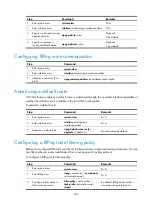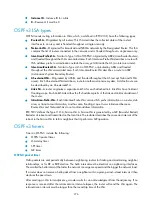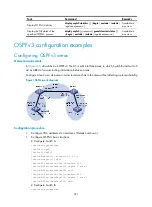
276
•
Instance ID
—Instance ID for a link.
•
0
—Reserved. It must be 0.
OSPFv3 LSA types
OSPFv3 sends routing information in LSAs, which, as defined in RFC 2740, have the following types:
•
Router-LSA
—Originated by all routers. This LSA describes the collected states of the router's
interfaces to an area, and is flooded throughout a single area only.
•
Network-LSA
—Originated for broadcast and NBMA networks by the Designated Router. This LSA
contains the list of routers connected to the network, and is flooded throughout a single area only.
•
Inter-Area-Prefix-LSA
—Similar to Type 3 LSA of OSPFv2, originated by ABRs (Area Border Routers),
and flooded throughout the LSA's associated area. Each Inter-Area-Prefix-LSA describes a route with
IPv6 address prefix to a destination outside the area, yet still inside the AS (an inter-area route).
•
Inter-Area-Router-LSA
—Similar to Type 4 LSA of OSPFv2, originated by ABRs and flooded
throughout the LSA's associated area. Each Inter-Area-Router-LSA describes a route to ASBR
(Autonomous System Boundary Router).
•
AS-external-LSA
—Originated by ASBRs, and flooded throughout the AS (except Stub and NSSA
areas). Each AS-external-LSA describes a route to another autonomous system. A default route can
be described by an AS-external-LSA.
•
Link-LSA
—A router originates a separate Link-LSA for each attached link. Link-LSAs have link-local
flooding scope. Each Link-LSA describes the IPv6 address prefix of the link and Link-local address of
the router.
•
Intra-Area-Prefix-LSA
—Each Intra-Area-Prefix-LSA contains IPv6 prefix information on a router, stub
area, or transit area information, and has area flooding scope. It was introduced because
Router-LSAs and Network-LSAs do not contain address information.
RFC 5187 defines the Type 11 LSA, Grace-LSA. A Grace-LSA is generated by a GR (Graceful Restart)
Restarter at reboot and transmitted on the local link. The restarter describes the cause and interval of the
reboot in the Grace-LSA to tell its neighbors that it performs a GR operation.
OSPFv3 timers
Timers in OSPFv3 include the following:
•
OSPFv3 packet timer
•
LSA delay timer
•
SPF timer
•
GR timer
OSPFv3 packet timer
Hello packets are sent periodically between neighboring routers for finding and maintaining neighbor
relationships, or for DR or BDR election. The hello interval must be identical on neighboring interfaces.
The smaller the hello interval, the faster the network convergence speed and the bigger the network load.
If a router does not receive a hello packet from a neighbor within a given period—dead interval, it then
declares the peer down.
After sending an LSA to its adjacency, a router waits for an acknowledgment from the adjacency. If no
response is received after the retransmission interval elapses, the router will send the LSA again. The
retransmission interval must be longer than the round-trip time of the LSA.
















































